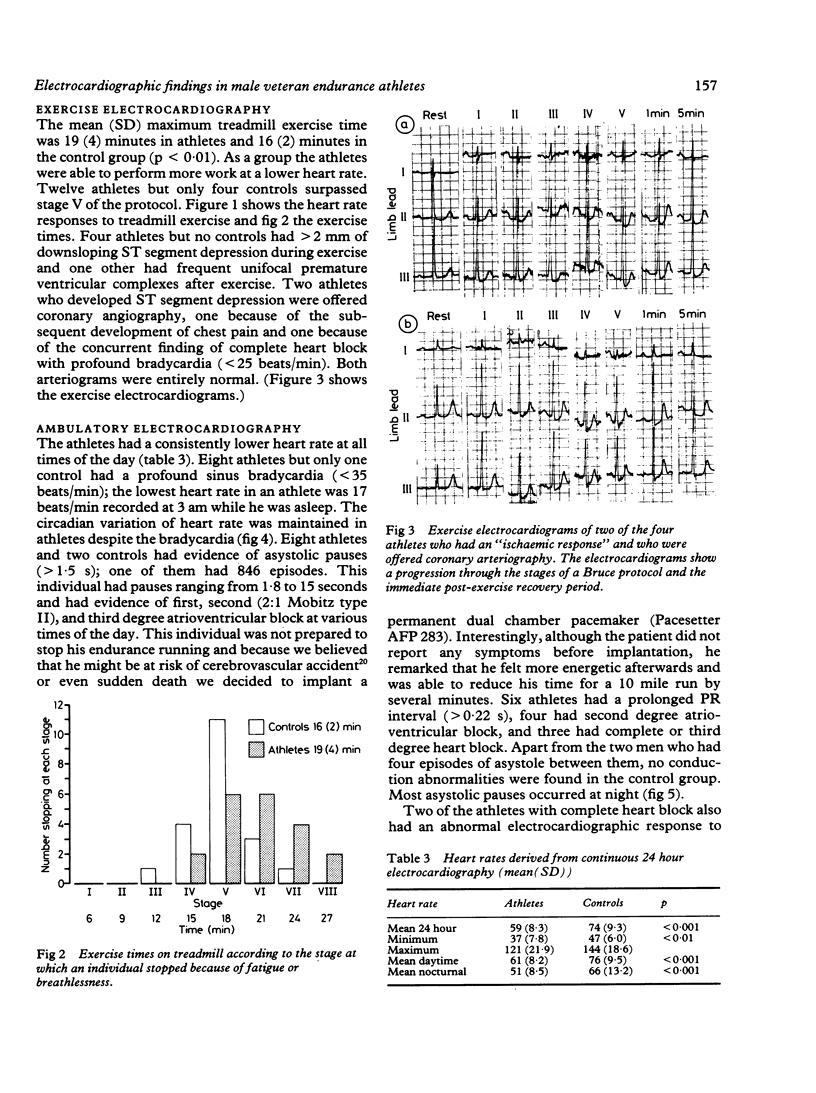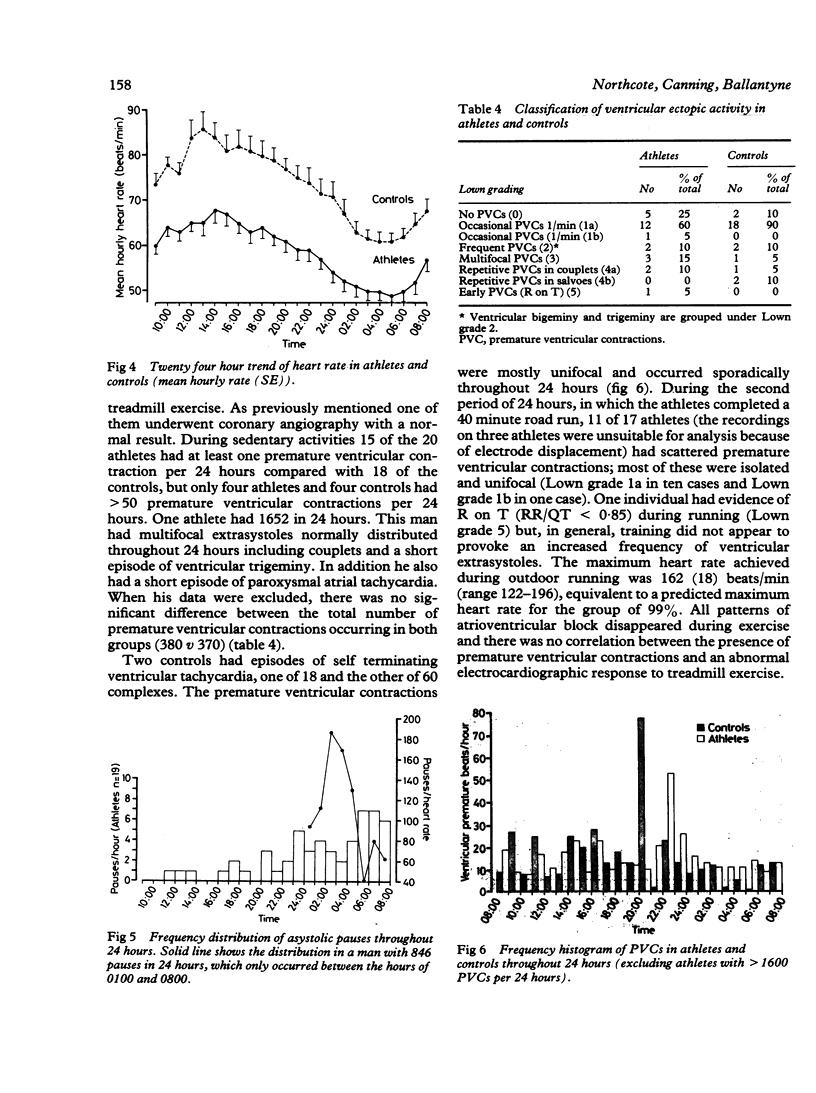Abstract
Twenty male veteran endurance runners and 20 controls underwent resting, exercise, and ambulatory electrocardiography. Four athletes and three controls satisfied voltage criteria for left ventricular hypertrophy. The PR interval was longer in the athletes and they had longer mean (SD) treadmill exercise times (19 (4) v 16 (2) min) than the controls. Four athletes but no controls had greater than 2 mm downsloping ST segment depression during exercise. During 48 hour ambulatory electrocardiography the athletes had a consistently lower heart rate but maintained a circadian variation. Profound bradycardia (less than 35 beats/min) occurred in eight athletes but only one control. Eight athletes and two controls had asystolic pauses ranging from 1.8 to 15 seconds. Six athletes had first degree heart block, four had Mobitz II second degree block, and three had complete heart block. Most conduction abnormalities occurred at night and resolved during exercise. Ventricular ectopic activity was not significantly different between the groups. Thus heart block patterns and profound bradycardia are more frequent in older athletes than their youthful counterparts.
Full text
PDF





Selected References
These references are in PubMed. This may not be the complete list of references from this article.
- Abdon N. J., Landin K., Johansson B. W. Athlete's bradycardia as an embolising disorder? Symptomatic arrhythmias in patients aged less than 50 years. Br Heart J. 1984 Dec;52(6):660–666. doi: 10.1136/hrt.52.6.660. [DOI] [PMC free article] [PubMed] [Google Scholar]
- Balady G. J., Cadigan J. B., Ryan T. J. Electrocardiogram of the athlete: an analysis of 289 professional football players. Am J Cardiol. 1984 May 1;53(9):1339–1343. doi: 10.1016/0002-9149(84)90090-0. [DOI] [PubMed] [Google Scholar]
- Ballantyne F. C., Clark R. S., Simpson H. S., Ballantyne D. The effect of moderate physical exercise on the plasma lipoprotein subfractions of male survivors of myocardial infarction. Circulation. 1982 May;65(5):913–918. doi: 10.1161/01.cir.65.5.913. [DOI] [PubMed] [Google Scholar]
- Beswick F. W., Jordan R. C. CARDIOLOGICAL OBSERVATIONS AT THE SIXTH BRITISH EMPIRE AND COMMONWEALTH GAMES. Br Heart J. 1961 Mar;23(2):113–130. doi: 10.1136/hrt.23.2.113. [DOI] [PMC free article] [PubMed] [Google Scholar]
- Blackburn H., Taylor H. L., Hamrell B., Buskirk E., Nicholas W. C., Thorsen R. D. Premature ventricular complexes induced by stress testing. Their frequency and response to physical conditioning. Am J Cardiol. 1973 Apr;31(4):441–449. doi: 10.1016/0002-9149(73)90292-0. [DOI] [PubMed] [Google Scholar]
- Bruce R. A., Gey G. O., Jr, Cooper M. N., Fisher L. D., Peterson D. R. Seattle Heart Watch: initial clinical, circulatory and electrocardiographic responses to maximal exercise. Am J Cardiol. 1974 Apr;33(4):459–469. doi: 10.1016/0002-9149(74)90602-x. [DOI] [PubMed] [Google Scholar]
- Clark R. S., Ballantyne D. Physical activity and coronary heart disease. Scott Med J. 1981 Jan;26(1):15–20. doi: 10.1177/003693308102600105. [DOI] [PubMed] [Google Scholar]
- Ector H., Bourgois J., Verlinden M., Hermans L., Vanden Eynde E., Fagard R., De Geest H. Bradycardia, ventricular pauses, syncope, and sports. Lancet. 1984 Sep 15;2(8403):591–594. doi: 10.1016/s0140-6736(84)90593-2. [DOI] [PubMed] [Google Scholar]
- Ehsani A. A., Martin W. H., 3rd, Heath G. W., Coyle E. F. Cardiac effects of prolonged and intense exercise training in patients with coronary artery disease. Am J Cardiol. 1982 Aug;50(2):246–254. doi: 10.1016/0002-9149(82)90173-4. [DOI] [PubMed] [Google Scholar]
- Eichner E. R. Exercise and heart disease. Epidemiology of the "exercise hypothesis". Am J Med. 1983 Dec;75(6):1008–1023. doi: 10.1016/0002-9343(83)90882-3. [DOI] [PubMed] [Google Scholar]
- Kambara H., Phillips J. Long-term evaluation of early repolarization syndrome (normal variant RS-T segment elevation). Am J Cardiol. 1976 Aug;38(2):157–156. doi: 10.1016/0002-9149(76)90142-9. [DOI] [PubMed] [Google Scholar]
- Lichtman J., O'Rourke R. A., Klein A., Karliner J. S. Electrocardiogram of the athlete. Alterations simulating those of organic heart disease. Arch Intern Med. 1973 Nov;132(5):763–770. [PubMed] [Google Scholar]
- Lown B., Wolf M. Approaches to sudden death from coronary heart disease. Circulation. 1971 Jul;44(1):130–142. doi: 10.1161/01.cir.44.1.130. [DOI] [PubMed] [Google Scholar]
- Meytes I., Kaplinsky E., Yahini J. H., Hanne-Paparo N., Neufeld H. N. Wenckebach A-V block: a frequent feature following heavy physical training. Am Heart J. 1975 Oct;90(4):426–430. doi: 10.1016/0002-8703(75)90421-4. [DOI] [PubMed] [Google Scholar]
- Northcote R. J., Canning G. C., Todd I. C., Ballantyne D. Lipoprotein profiles of elite veteran endurance athletes. Am J Cardiol. 1988 Apr 15;61(11):934–936. doi: 10.1016/0002-9149(88)90381-5. [DOI] [PubMed] [Google Scholar]
- Ordway G. A., Charles J. B., Randall D. C., Billman G. E., Wekstein D. R. Heart rate adaptation to exercise training in cardiac-denervated dogs. J Appl Physiol Respir Environ Exerc Physiol. 1982 Jun;52(6):1586–1590. doi: 10.1152/jappl.1982.52.6.1586. [DOI] [PubMed] [Google Scholar]
- Paffenbarger R. S., Jr, Hyde R. T. Exercise as protection against heart attack. N Engl J Med. 1980 May 1;302(18):1026–1027. doi: 10.1056/NEJM198005013021810. [DOI] [PubMed] [Google Scholar]
- Palatini P., Maraglino G., Sperti G., Calzavara A., Libardoni M., Pessina A. C., Dal Palù C. Prevalence and possible mechanisms of ventricular arrhythmias in athletes. Am Heart J. 1985 Sep;110(3):560–567. doi: 10.1016/0002-8703(85)90075-4. [DOI] [PubMed] [Google Scholar]
- Pantano J. A., Oriel R. J. Prevalence and nature of cardiac arrhythmias in apparently normal well-trained runners. Am Heart J. 1982 Oct;104(4 Pt 1):762–768. doi: 10.1016/0002-8703(82)90008-4. [DOI] [PubMed] [Google Scholar]
- Pilcher G. F., Cook A. J., Johnston B. L., Fletcher G. F. Twenty-four-hour continuous electrocardiography during exercise and free activity in 80 apparently healthy runners. Am J Cardiol. 1983 Oct 1;52(7):859–861. doi: 10.1016/0002-9149(83)90428-9. [DOI] [PubMed] [Google Scholar]
- Redwood D. R., Rosing D. R., Epstein S. E. Circulatory and symptomatic effects of physical training in patients with coronary-artery disease and angina pectoris. N Engl J Med. 1972 May 4;286(18):959–965. doi: 10.1056/NEJM197205042861801. [DOI] [PubMed] [Google Scholar]
- Talan D. A., Bauernfeind R. A., Ashley W. W., Kanakis C., Jr, Rosen K. M. Twenty-four hour continuous ECG recordings in long-distance runners. Chest. 1982 Jul;82(1):19–24. doi: 10.1378/chest.82.1.19. [DOI] [PubMed] [Google Scholar]
- Van Ganse W., Versee L., Eylenbosch W., Vuylsteek K. The electrocardiogram of athletes. Comparison with untrained subjects. Br Heart J. 1970 Mar;32(2):160–164. doi: 10.1136/hrt.32.2.160. [DOI] [PMC free article] [PubMed] [Google Scholar]
- Viitasalo M. T., Kala R., Eisalo A. Ambulatory electrocardiographic findings in young athletes between 14 and 16 years of age. Eur Heart J. 1984 Jan;5(1):2–6. doi: 10.1093/oxfordjournals.eurheartj.a061546. [DOI] [PubMed] [Google Scholar]
- Viitasalo M. T., Kala R., Eisalo A. Ambulatory electrocardiographic recording in endurance athletes. Br Heart J. 1982 Mar;47(3):213–220. doi: 10.1136/hrt.47.3.213. [DOI] [PMC free article] [PubMed] [Google Scholar]
- Viitasalo M. T., Kala R., Eisalo A., Halonen P. I. Ventricular arrhythmias during exercise testing, jogging, and sedentary life: a comparative study of healthy physically active men, healthy sedentary men, and men with previous myocardial infarction. Chest. 1979 Jul;76(1):21–26. doi: 10.1378/chest.76.1.21. [DOI] [PubMed] [Google Scholar]
- Zeppilli P., Pirrami M. M., Sassara M., Fenici R. T wave abnormalities in top-ranking athletes: effects of isoproterenol, atropine, and physical exercise. Am Heart J. 1980 Aug;100(2):213–222. doi: 10.1016/0002-8703(80)90117-9. [DOI] [PubMed] [Google Scholar]


